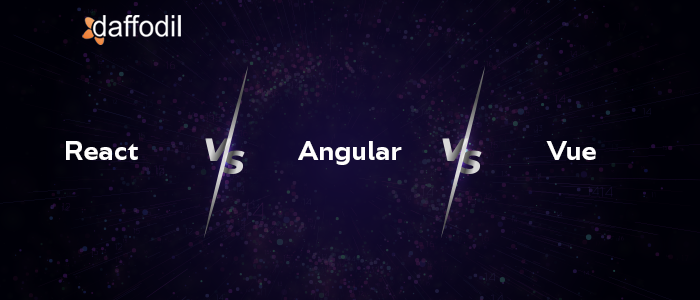
Even in this dynamic and rapidly evolving digital world, JavaScript has withstood the test of time and is here to last for long. Due to its efficiency and flexibility, it can be deployed both on the server-side and the client-side, and can be used for developing mobile and web applications. No doubt, it is one of the widely accepted programming languages.
But like any technology, JavaScript has its downsides. It is a very complicated language, and it is difficult to master its structure as well as its unique characteristics. To overcome this, developers have discovered a new approach – Frameworks. These function as a structure for the programs, specifying our program's standards and protocols and simplifying other aspects for us, like those of syntax and upkeep.
In this article, we analyze three popular latest frameworks, i.e., React, Angular and Vue, and try to compare their features. The focus of this discussion would specifically be around their efficiency, success, and output, along with their technical nuances to help you decide which one to opt for when developing your next disruptive application.
Evolution of JavaScript Frameworks
1. React
In 2010, Facebook released the first nascent React as an open-source syntax and thus allowed creating synthesized components. But, as Facebook advertisements became impossible to handle with the basic HTML code, developers began searching for the ideal solution, and React was released in 2013 with the introduction of a unique function - the virtual DOM. It enabled the creation of single-page applications and sought primarily to split the UI into a series of GUI elements to simplify the user interface during the code writing process.
2. Angular
The history of Angular can be traced back to AngularJS. The very first AngularJS witnessed its dawn as a front-end framework in 2010. However, Google's team of programmers and developers didn't let it be, and in 2016, offered the Angular as you know it today, which is majorly focused on its three key elements — TypeScript, RxJS, and Zone.js. Presently, Angular has eliminated its JS suffix following its last update in May 2019.
3. Vue
It is the latest and perhaps most influential member of the Javascript Platform family. Vue was developed by Google's ex-engineer, who had previously worked on the team that brought forth Angular. Vue came out with version 2.6.11 in December 2019, intending to replace all the disadvantages of its peer platforms with new versatility to build web-based applications without complications.
An Overview of Technical Pros and Cons
This section can help you determine if any of these three particular frameworks can help address your particular issues.
React
In a nutshell, React is suitable for the development of single-page apps of any size/scale.
Pros:
- Rapid processing, because of React's Virtual DOM, and other extensive optimization for rendering.
- The 'create-react-app' application generator provides comprehensive support for developing Progressive Web Apps (PWA).
- React incorporates the principles of Functional Programming (FP), to develop easy-to-test and highly reusable codes.
- Smooth migration between versions with ‘code mods’ based automation.
- It has less unwanted side effects with one-way data binding.
- It is also a robust framework for content-focused applications since it supports server-side rendering.
Cons:
- React users are polarized between standard stylesheets (CSS Modules) and CSS-in-JS (i.e., Emotion and Modeled Components) when it comes to the right way to write CSS in React.
- React is moving away from class-based components, which may be a barrier for developers more comfortable with Object-Oriented Programming (OOP).
Angular
Angular is best suitable for creating highly interactive web applications.
Pros:
- MVVM (Model-View-ViewModel) enables developers to work with the same collection of data simultaneously on the same app section. Angular is also paired with Typescript and has immense support for it.
- With the ‘view’ part on the client-side, the MVC model enables separation of concerns, thereby drastically reducing background queries.
- It has both one-way data binding and two-way data binding.
- Thanks to its architecture and structure, it provides excellent scalability.
- Great for developing long-term investment-savvy real-time native, hybrid, or web applications like chat apps or message apps.
Cons:
- Slower output when compared to industry benchmarks.
- A multitude of separate constructs (Injectables, Pipes, Modules, etc.) makes development a bit more complicated compared to React and Vue.js, which were created with a single "Component" in focus.
Vue
Vue ideally suits businesses looking to build highly adaptable user interfaces.
Pros:
- Vue provides detailed documentation that quickens the developer’s learning curve and saves a considerable amount of time when designing an app with only the elemental knowledge of HTML and JavaScript.
- Vue can help create fairly substantially large reusable layouts due to its uncomplicated structure.
- Vue.js can size about 20 KB while retaining its speed and versatility that makes for many superior results in comparison to its peer frameworks.
- Increased HTML functionality. This simplifies the treatment of HTML blocks with its assortment of various components.
- Its smaller interactive parts can be integrated into the existing infrastructure easily.
Cons:
- At times, Vue may have trouble in integration into the popular platforms, and the possible solution is yet to be discovered.
- Compared with React or Angular, Vue has relatively low market shares and hence fewer resources, which means its information system is still in infancy.
Which Organizations Are Using These Frameworks?
These three frameworks have evolved from their nascent state into being universally acknowledged and are enabling several massive projects.
- React — React is integral to the development of Facebook, Netflix, Paypal, Tumblr, Instagram, Uber, Reddit, and several others.
- Angular — Angular is used by multiple Fortune 500 firms, as well as Santander Bank, Google, BMW, and WhatsApp.
- Vue — Vue has been extensively used by companies like Alibaba, Baidu, 9GAG, GitLab, and more.
Final Words:
While each of the frameworks has its own pros and cons, how they evolve in the future is unknown. Based on the discussion in this blog, you can identify the best framework that suits your specific needs keeping the pros in mind because the communities that back these frameworks are continuously working to eliminate the cons.



